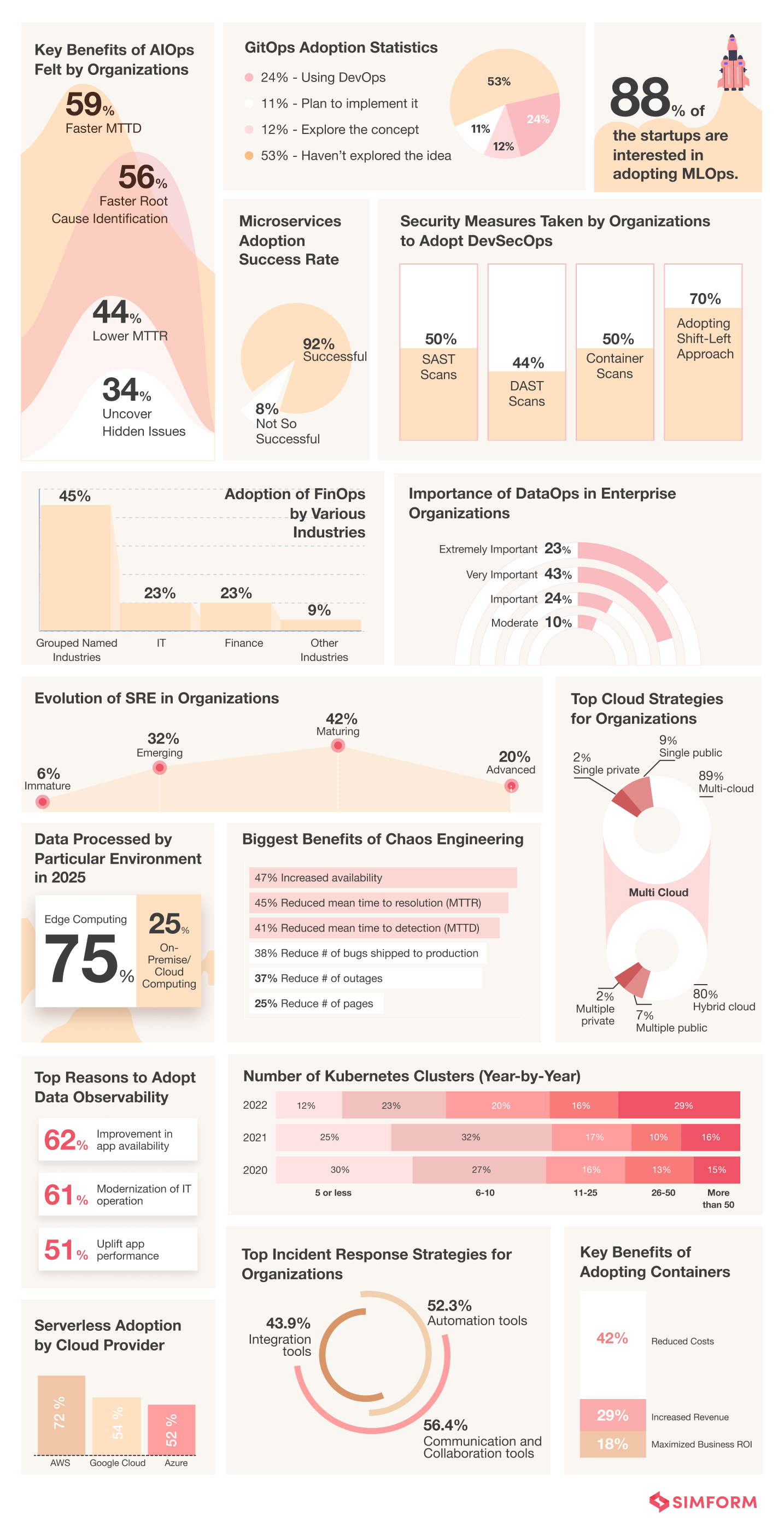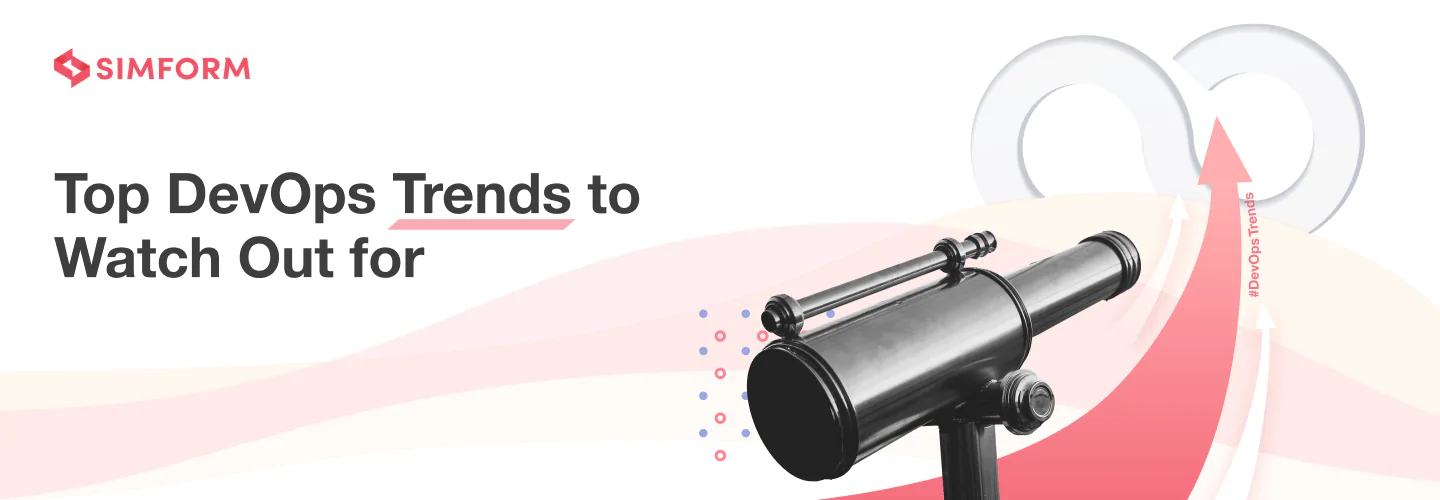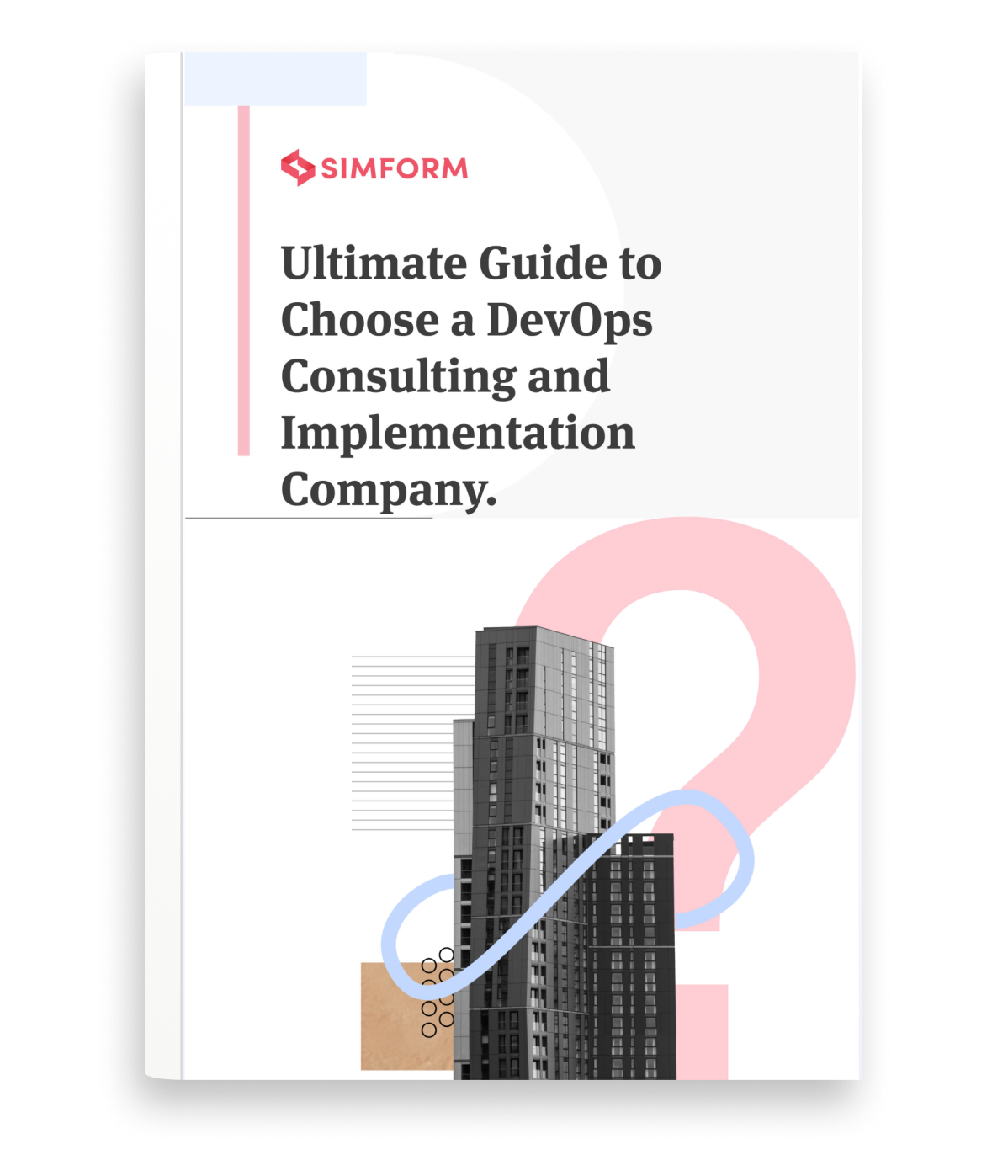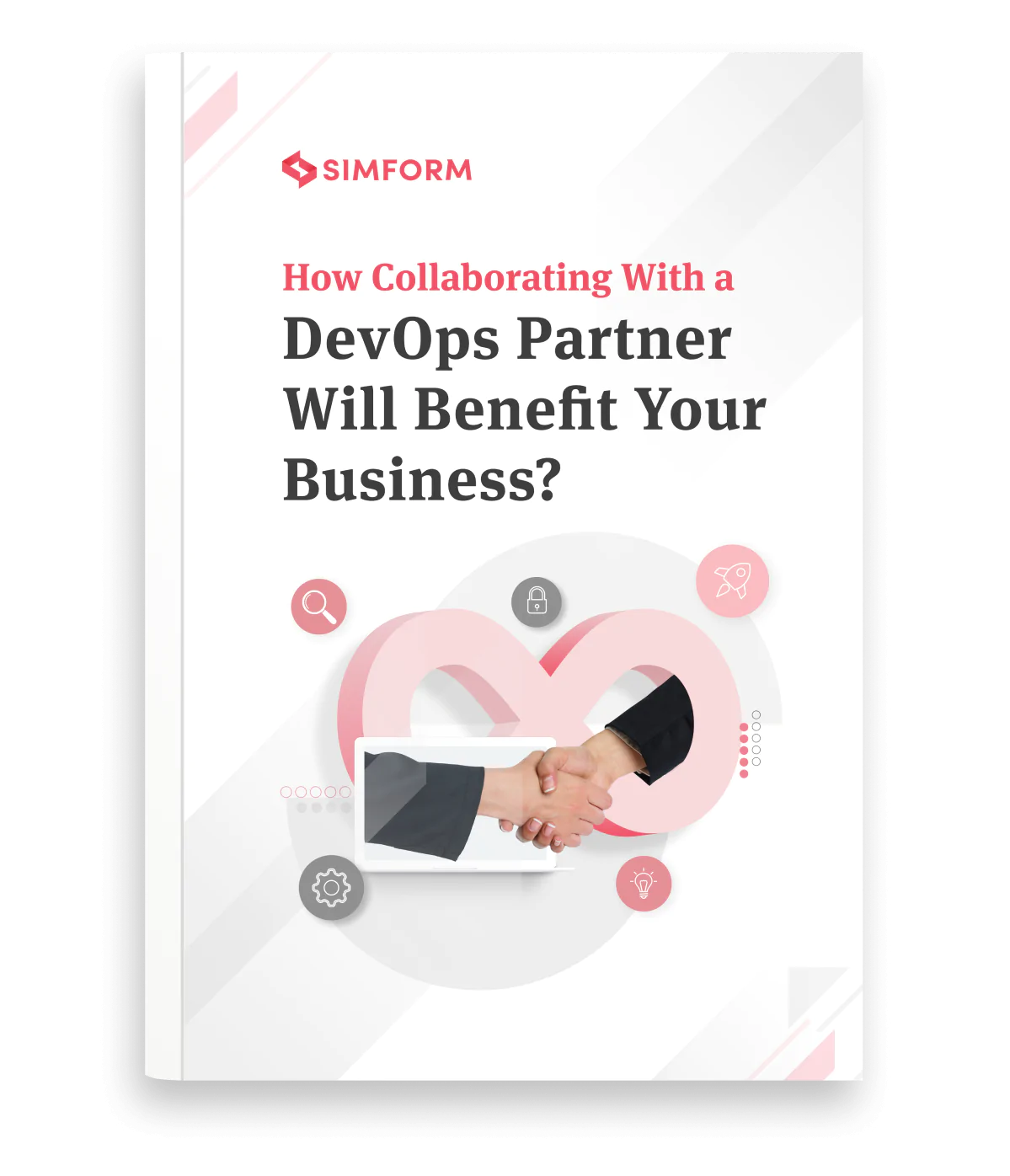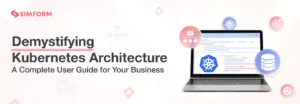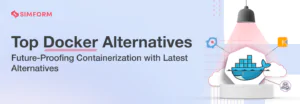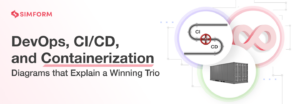Top 18 DevOps Trends to Watch Out for in 2024 and Beyond
In 2015, Adidas released Yeezy sneakers, which went viral, with a sale of 2600 shoes within five minutes. It was an excellent sign for business but scary for the IT team dealing with the traffic surge. The website crashed when they released the second stock. That’s where the Adidas engineering team transformed and adopted cloud-native infrastructure, Kubernetes, and DevOps. It increased their release frequency from six weeks to five times a day.
Many other companies have successfully adopted DevOps in their ecosystem. But not everyone is flourishing. Therefore, you need to be aware of the right DevOps trends. Capitalizing on the right trend reduces the risk of failure, streamlines effort, and thus improves the chances of a successful implementation.
In this article, we share with you the top DevOps trends you should know. We’ve also shared the success stories of companies utilizing these trends to propel themselves ahead of the competition. So, let’s dive deep into the ocean of DevOps and analyze the trends that will shape the industry in 2024 and beyond.
Top 18 DevOps trends for 2024 that will shape the industry
1. GitOps: A framework to implement DevOps best practices
GitOps is one of the latest DevOps trends added to the DevOps workflow. It helps automate and control infrastructure. It’s a Kubernetes-based paradigm that enables developers and IT operation managers to use Git for merging and deploying various applications. GitOps considers all the DevOps best practices, such as version control, collaboration, compliance, and CI/CD, and applies them to infrastructure automation. In addition, it also focuses on incremental releases and continuous delivery to build, test, and deploy software quickly and efficiently.
Mettle increased production speed by 75% and deployment by 25% by adopting GitOps
Mettle is a finance firm powered by Natwest that aims to provide small business customers with an application that speeds up payments and helps them manage their finances. Therefore, it needed to ensure that all the services were up and running 24*7. The scenario challenged the engineering team to find a way where they deploy new features quickly without compromising the reliability or security of CI/CD pipelines. That’s where Mettle partnered with Weaveworks and adopted a GitOps approach. It allowed Mettle to create a self-service platform for engineers to concentrate on delivering business value through innovation without the absolute need for Platform Team assistance, which increased production by 50% and deployment by 25%. They also reduced MTTR to 20 mins and the role of developers on the operation side by 75%.
2. AIOps/MLOps: Automating IT operations and processes
AIOps and MLOps are two of the DevOps market trends, with the prediction of it becoming a $40.91 billion entity by 2026. Optimizing DevOps processes is essential to obtain the benefits of quick-release and high quality, where AIOps and MLOps have a significant role to play. While AIOps can help you automate IT operations and processes, MLOps standardizes the ML system development. So, with AIOps, you can identify the root cause of any problem hampering productivity; MLOps can help you streamline processes and increase productivity.
HCL reduced MTTR by 33% for the hybrid cloud-managed services by adopting AIOps
HCL provides continuous assistance to their enterprise customers migrating to a cloud or moving to CI/CD approach with a ‘detect and resolve’ method that uses manual procedures. However, as the complexity of the IT environment increased, relying on a manual process was becoming complicated with higher operational costs, longer time for root cause analysis, and service restoration delays. That’s where HCL collaborated with Moogsoft.
HCL developed a platform called DRYiCE IntelliOps, a solution addressing an enterprise’s full-stack AIOps and observability needs. While DRYiCE transformed HCL’s customers from reactive to proactive incident management by offering more infrastructure visibility, Moogsoft supports its customers’ transition to agile business practices without increasing HCL’s costs of operations. As a result, it helped HCL reduce MTTR by 33%, help desk tickets by 62%, and ensure a seamless cloud migration.
PepsiCo identified consumer shopping trends and produced actionable insights by adopting MIOps
PepsiCo is one of the world’s largest foods and beverage companies, so it needs a first-hand view of its consumers and should have one eye on the production. In addition, there needs to be a constant balance between the produce and the number of consumers, which means the company needs to predict future requirements. That’s where PepsiCo partnered with Microsoft Azure and used its MLOps capabilities.
Pepsico had tons and tons of raw data with it that was collected over the past 20 years in the form of spreadsheets, PDF files, Word documents, PowerPoint decks, databases, and emails. However, there was no streamlining of data, and that’s where Azure’s machine learning capabilities came into play. The firm transferred Pepsico’s humongous data to Azure’s machine learning models. The entire process was structured as continuous integration and continuous delivery (CI/CD) pipeline. It helped PepsiCo identify consumer shopping trends and learn store-level product insights to better prepare for the future.
3. DevSecOps: Enforcing security, observability, and governance in DevOps
Security has always been a significant concern in the digital world. DevSecOps integrates the best practices in the DevOps lifecycle, emphasizing security, observability, and governance. It states that security should follow a shift-left approach and not be an afterthought. The current DevSecOps trends tell us that 50% of enterprises run the SAST test, 40% run DAST, and 50% scan containers and dependencies.
Pokemon Go adopts DevOpSecOps to protect children’s privacy
Pokemon Go was a success; however, it created liability issues. Out of its 800 million downloads, most were from children. And as per GDPR, they had to protect the privacy of every child. But, the twist here was that Pokemon Go partnered with Google spin-off Niantic to develop Pokemon Go and shared responsibilities regarding development and security compliance. So, a certain percentage of backend and Child Care Security Compliance was Pokemon Go’s responsibility, while who runs the application was to be seen by Niantic.
With so much third-party data and shared responsibility, inculcating a security culture and collaboration was paramount. That’s where the company adopted DevSecOps and put automated security checks in place that monitor the application privacy from the initial phase. With the help of this culture shift, Pokemon Go protected children’s privacy.
4. FinOps: Optimizing cloud spending by bringing financial accountability
FinOps is one of the DevOps industry trends that describes the best practices for optimizing cloud spending to increase profit margins for the company. It brings financial accountability to cloud expenditures by collaborating with various teams to strike a balance between speed, cost, and quality. As of 2022, 43% of CTOs, 24% of CIOs, and 17% of CFOs collaborate with the FinOps team in an enterprise-level organization.
The Wire reduced its cloud compute spending by 80% by adopting FinOps
The Wire is one of the most renowned media institutions that uses AWS to fulfill its infrastructure needs. It gave them high performance, reliability, scalability, and security, but they had to pay a lot. In addition, they had no control over cloud spending; there was a lot of wastage of resources and mismanagement of cloud infrastructure. That’s where The Wire collaborated with Centilytics and adopted their FinOps solution.
The solution thoroughly studied The Wire’s cloud architecture, resource usage, and utilization and created custom reports for improvement. It also implemented the wastage tracker by identifying multiple orphaned resources. As a result, it helped them reduce the spending on AWS cloud compute instances by 80%, EC2 by 25%, RDS by 30%, and cloud infrastructure costs by 15%.
5. DataOps: Accelerating development by optimizing data pipelines
DataOps is a set of technical practices, workflows, cultural norms, and architectural patterns that aim to bring faster release, high-quality data, collaboration, and monitoring. All these are significant DevOps features, so there is no surprise that 89% of firms will utilize DataOps in the upcoming years. DataOps aligns people, processes, and technology to enable agile and secure data management. DevOps and DataOps accelerate development, but DevOps focuses more on delivery, while DataOps focuses more on data pipeline integration.
Gogo improved service quality and decreased operational cost by adopting DataOps
Gogo is one of the leading in-flight connectivity and entertainment providers in 16+ airlines. The connectivity equipment is installed on over 2900 commercial flights. Initially, there was no centralized repository for this data collection, so processing data and finding insights was a massive challenge. As a result, Gogo collaborated with N-iX and developed a single unified DataOps platform. It helped Gogo analyze patterns in performance that improved service quality. It also reduced operational expenses and enhanced the quality of connectivity.
6. Chaos engineering: Building resilient software systems by reducing their unpredictability
Chaos engineering is a method of testing the reliability of the software by deliberately introducing failure or faulty scenarios, also known as creating chaos. Causing these random disruptions will force applications to behave differently, and they might break under immense pressure. Engineers can then analyze and identify the root cause of problems and treat them before production deployment. Continuous testing, improvement, and reliability are pillars of DevOps, and chaos engineering aims to facilitate that aspect. Gartner predicts that almost 40% of DevOps firms will implement chaos engineering by 2023.
Netflix increased its fault tolerance capabilities by adopting chaos engineering
Until 2008, Netflix relied on on-premise data center management services, but a sudden outage blew away all the essential data of Netflix. It made the engineering team think profoundly and decided to move to cloud infrastructure to avoid further mishaps. However, the engineers still felt that you need to have continuous monitoring in place to prevent failure. That’s where the idea of Chaos Monkey came into the picture.
Chaos Monkey is a script that runs continuously in all Netflix environments, randomly killing production instances and services in the architecture. It helped the engineering team test its ability to survive unexpected outages without impacting the consumers. With the help of this tool, developers could identify weaknesses, build automated recovery mechanisms and increase fault tolerance.
Let's Understand How Netflix Became A Master of DevOps?
7. Site reliability engineering (SRE): Accelerating software delivery by ensuring reliability
Site Reliability Engineering (SRE) is a software engineering approach to IT operations where you use software tools to manage systems, solve problems, and automate operations tasks. The question is, what does DevOps do to SRE? SRE helps you to create scalable and highly reliable software systems. That’s why SRE is one of the most demanding LinkedIn jobs of 2022, shaping the IT industry.
PayPal improves its customer satisfaction ratio by adopting SRE practices
As per Deloitte, SRE is not about a number, it’s about reliability in terms of customer satisfaction, and PayPal followed that principle. To improve the customer experience of PayPal, it created a team for SRE. After nine months of consultation and architectural changes, the SRE team helped PayPal reduce its MTTR by 90% for the most critical operations, increasing the customer satisfaction ratio. Moreover, PayPal also saved $20M in that calendar year.
8. Hybrid deployment: Reducing infrastructure cost and time-to-market
Hybrid deployment combines the power of on-premise infrastructure with cloud computing resources. The significant benefit of this approach is that you don’t have to worry about full-fledged cloud migration; you just need to augment on-premise resources and create an alternate path to the cloud provider. In addition, collaboration is the heart and soul of DevOps, and the hybrid approach will allow team members working in-house and remotely to work together.
British Petroleum (BP) streamlined its business processes with a hybrid deployment
British Petroleum (BP) is one of the largest oil and gas companies that spend millions of dollars on managing infrastructure needs with mega data centers in 70+ countries. BP spent more time on data center management and less on application development. They collaborated with Microsoft Azure and adopted a hybrid deployment approach. The regulatory and compliance feature remained in the on-premise environment while the data center workload shifted to the cloud. It helped them streamline business processes and become more agile.
9. Automation: Facilitating a constant feedback loop between various teams
DevOps automation aims to perform repetitive tasks with minimal manual intervention and create procedures that facilitate a feedback loop between operation and development teams. With this approach, you can perform incremental deployments and ensure faster releases. As a result, 90% of the enterprises that have adopted DevOps are likely to opt for automated procedures. In addition, predictive analysis is also used in DevOps pipelines to detect and treat problems.
Woven Planet achieved continuous delivery and minimal downtime by adopting automation
Woven Planet works with Toyota Research Institute and provides high-end mobility solutions. It adopted Toyota’s principles of continuous improvement to foster innovation and agile development. However, achieving those goals seemed out of reach with the traditional waterfall approach to the automotive industry tasks. That’s where Woven Planet collaborated with JFrog and adopted DevOps automation to facilitate continuous integration and delivery practices. With automated procedures, Woven Planet ensured faster delivery and minimal downtime.
10. Infrastructure as a Code (IaC): Ensuring rapid deployment by eliminating manual processes
Infrastructure as a Code (IaC) is a DevOps market trend that facilitates the management and provisioning of infrastructure through code instead of manual processes. With IaC, you can align development and operations teams as both will utilize the same description for application deployment. Some of the critical benefits of IaC are infrastructure standardization, consistent deployment, and rapid implementation.
Asian Development Bank (ADB) reduced VM provisioning time and improved security by adopting IaC
ADB was using on-premise data centers to manage the workflow until 2018. However, just before 2019, the digital transformation began when the bank realized working traffic surges and maintaining peak performance was an obstacle. That’s where the move to the cloud started, but the conventional cloud migration strategies weren’t giving the desired results. So they opted for automation and partnered with Terraform, an IaC platform. With this approach, ADB reduced VM provisioning time from three to two days and enabled the ability to deploy automated network configurations in less than five minutes to enhance resiliency, flexibility, and security.
11. Serverless computing: Eliminating the gap between Dev and Ops to facilitate faster time-to-market
Serverless computing allows you to build and run applications and services without thinking about servers. Serverless applications don’t require you to manage servers, as they are abstracted away from app development. Over the last few years, serverless has become one of the most innovative and exciting approaches to deploying software, with the serverless market reaching $30 billion by 2030. Also, more than 50% of cloud-based enterprises have adopted serverless. Serverless brings many advantages to the DevOps process, like operability, as it eliminates the gap between Dev and Ops. It also generates the code for the DevOps pipeline without the host needing to build, test, and deploy.
Autodesk reduced account-creation time by 99% after opting for serverless computing
Autodesk designs software for architecture, construction, engineering, and manufacturing. It has been expanding its AWS footprints to streamline development and facilitate faster time-to-market. However, account creation for AWS still required a two-week-long manual process. As the number of accounts grew, Autodesk couldn’t sustain its peak performance. So they opted for AWS Lambda and AWS Dynamodb as a part of their serverless transition. It helped Autodesk reduce account creation time by 99%, i.e., from two weeks to 10 minutes.
12. Cloud-native infrastructure: Reducing time-to-market and increasing scalability of software
Cloud-native infrastructure plays the role of hardware and software by running and supporting applications that exist only in the cloud. It aims to reduce go-to-market time and bring more efficiency, which aligns with the goal of DevOps. Therefore, businesses should implement a Cloud Management Platform (CMP) to adopt cloud-native infrastructure. It would help them to manage and utilize cloud resources efficiently.
PNC bank automated its software supply chain compliance by adopting cloud-native infrastructure
PNC Bank is one of the largest banks in the United States, with an asset of $367 billion. The bank’s massive IT footprint is supposed to deliver new features and meet regulatory compliance requirements. However, they were following a manual process that took 30-days. So, PNC Bank partnered with CNCF and utilized its solution Knative, the cloud-native serverless and eventing framework. It helped PNC bank in automating code checking and version control. They also used TriggerMesh to stop the code from going into production before the regulatory check. These helped PNC save 30-days of the development cycle and scaled them to 20K code repositories.
13. Microservice architecture: Opening the door for continuous and frequent delivery of applications
So, microservice architecture or microservices are dominating the IT industry. They are tailor-made for DevOps trends because it aims to break down monolithic applications into smaller and manageable chunks, simplifying development, testing, and deployment. It also facilitates continuous and frequent delivery of applications. With microservices, it’s simpler to streamline DevOps processes and improve the overall quality of products.
Coca-Cola reduced network congestion and scaling time by adopting microservices
Coca-Cola has over 3800 products worldwide. As the company was using legacy-based architecture, connecting all the entities of different continents and supporting their incremental growth was a massive challenge. As a result, the IT teams chose microservices and a DevOps-based approach. It created a separation of concerns and reusable modules that contributed to the speed and agility of the product. With microservice architecture, Coca-Cola reduced the data flow in the network by 50% and the time required to scale up to support more freestyle machines from weeks to a few minutes.
14. Containerization: Providing a solid base for continuous deployment and delivery
Containerization is one of the current DevOps trends that deal with the packaging of software that contains elements such as libraries, frameworks, and other dependencies. Today, 50% of the applications use containers, and there has been a 109% increase in their use in the last five to six years. Containers are lightweight and self-contained, making them easy to host, build, test, and deploy. Continuous deployment and continuous delivery are two building blocks of DevOps, and that’s where containerization plays a significant role because each container carries software with all its dependencies that ensure faster app deployment and delivery.
MetLife improved scalability and reduced total cost by 66% with containerization
MetLife is one of the biggest insurance provider firms. The heavyweight has over 400 systems residing in legacy-based architecture. It was hampering the customer experience and productivity of the application. The engineers decided to move to microservices and Docker to solve complexities within microservices. By taking this step, MetLife divided various pieces of business logic into modular parts, increasing their scalability. Also, with containerization, they could decrease VMWare footprints by 70%, which reduced their total cost of ownership by 66%.
15. Kubernetes: Ensuring minimal deployment time by enabling autoscaling of resources
Kubernetes (K8) is a portable, extensible, open-source platform for managing containerized workloads and services. It offers an autonomous and continuous container-based integration ecosystem that allows developers to scale up or down the resources. That is why 48% of developers today use Kubernetes for container orchestration. In addition to all these numbers, Kubernetes facilitates cross-functional collaboration and ensures minimal deployment downtime, aligning with DevOps standard best practices.
Nordstrom increased operational efficiency and reduced deployment time with Kubernetes
Nordstrom, Inc. is an American luxury department store chain headquartered in Seattle, Washington. Being an e-commerce company, speed, agility, and a good experience were vital for Nordstrom. So, they started using Kubernetes to seek a DevOps transformation and implemented continuous integration and deployment pipelines. As a result, it helped them reduce deployment time from three months to 30 minutes. Moreover, Kubernetes increased its operational efficiency and VM cluster efficiency by 10x.
CTOs Handbook to Build an Enterprise Kubernetes Strategy
16. Edge computing: Bringing enterprise apps closer to their source of truth to improve response time
Edge computing is a distributed computing framework that aims to bring enterprise applications closer to the source of truth, such as IoT or local servers. The benefits of this system are faster insights, improved response times, and better bandwidth availability. The edge computing market will become $275 million by 2025 and get used in 5G, IoT, AI, etc., where you need a quick response and delivery, and CI/CD does that.
Daihen Corporation doubled its plant’s output by adopting edge computing
Daihen Corporation is an electronics manufacturing company with headquarters in Osaka, Japan. In 2017, the company surveyed processes to improve the plant’s productivity and found that 200 manual inspections took 30% of the production time. So Daihen patterned with FogHorn Systems, which helped them develop an intelligent solution by combining AI, IoT, and Edge Computing. As a result, manual processes were reduced by 70%, saving 5000 production hours, and automated procedures came into the picture that doubled the plant’s productivity.
17. Data observability: Empowering teams to identify, troubleshoot, and resolve data issues
Data Observability deals with the health and the state of the data in your system. It involves activities to identify, troubleshoot, and resolve data issues in real-time. Continuous monitoring is one of the critical elements of the DevOps lifecycle, and that’s where observability plays a crucial role. Industry leaders who have adopted observability have saved over $20 million by reducing downtime. Observability leaders have reported 60% more successful product launches and a 69% increase in MTTR for unplanned downtime or degradations.
Lenovo offers a frictionless e-commerce experience by adopting a data observability tool
Lenovo is one of the finest consumer electronics companies in the world and has set up an e-commerce marketplace. However, the main challenge for Lenovo was managing unexpected web traffic and data usage spikes. So naturally, performance, stability, and flexibility became their top priorities, especially when moving the resources to the cloud. That’s where Lenevo partnered with Splunk and utilized its observability tools that helped them cut troubleshooting time in half, reduced the total cost, and maintained 100% uptime despite a 300% increase in web traffic.
18. Platform engineering: Ensuring seamless collaboration between Dev, Ops, and SRE
Platform engineering is one of the critical DevOps trends for 2023 that focuses on building toolchains and workflows to enable self-service capabilities. In addition, platform engineering is about developing an ecosystem that ensures seamless collaboration between Dev, Ops, and SRE. Lastly, many firms struggle with manual procedures in code deployment; that’s where platform engineering can reduce the cost of this operation by enabling automation.
Travel Brands successfully expanded its business globally by adopting platform engineering services
Travel Brands is a travel company in Canada that was seeking a global expansion. T The legacy architecture of their flight booking engine made it a considerable challenge to add new features. To overcome this, they collaborated with Techspian to utilize platform engineering services. As a result, It helped Travel Brands build a multi-GDS B2B flight booking experience and develop integrated profile management and contact management system. As a result, it enhanced their customer experience and paved the way for global expansion.
Want to leverage DevOps trends for digital transformation?
Knowing and implementing the latest DevOps trends requires a lot of practice, skill, and domain knowledge. Therefore, you need a partner that has done it before and has the capabilities to manage any complex matter.
CrayPay wanted to build a scalable mobile solution to support the n-number of users. They also wanted us to improve the customer experience by reducing checkout time. That’s where SIMFORM came into play. Our engineering team understood the requirements and crafted a scalable and secure solution. We also emphasized continuous testing and adopted Firebase A/B testing to ensure a rich customer experience before the product goes live. It helped CrayPay retain users and reduce development time. Continuous testing and monitoring is a core part of the DevOps lifecycle that helped CrayPay seek digital transformation.
Do you want to transform your enterprise by leveraging the latest DevOps trends? Then, look no further beyond SIMFORM. We’re one of the best DevOps-managed service providers that help you synchronize your development and operational capabilities to accelerate product lifecycle and ensure faster frequent releases. Contact us for expert consultation and avail of a next-generation transformative solution.
Bonus Infographic: A Statistical Analysis of DevOps Trends
